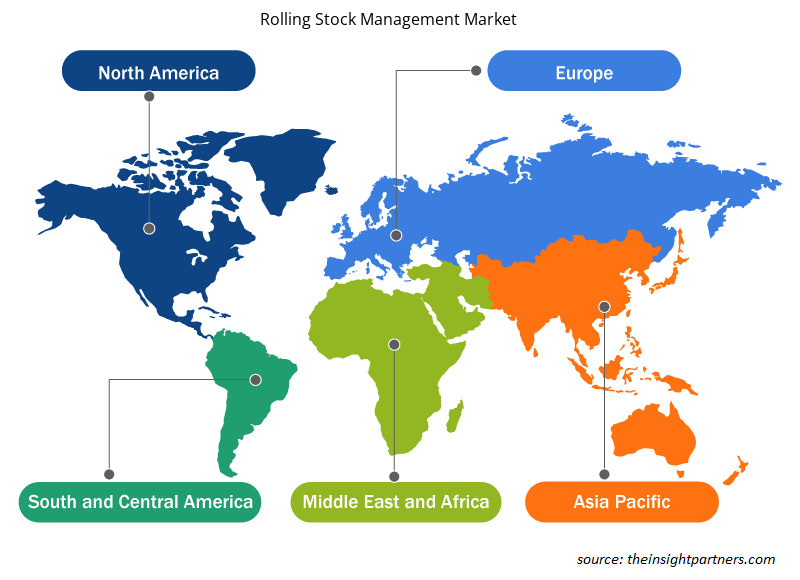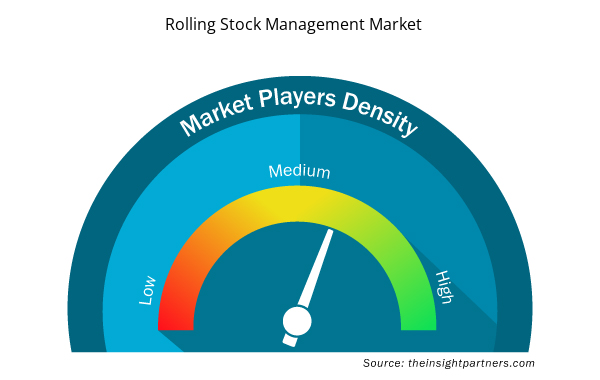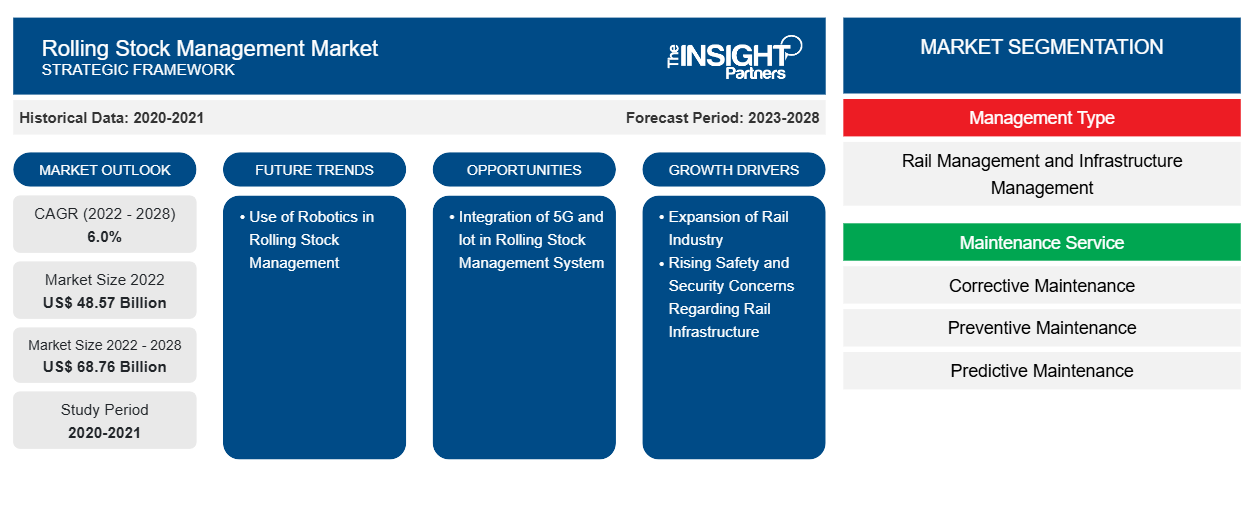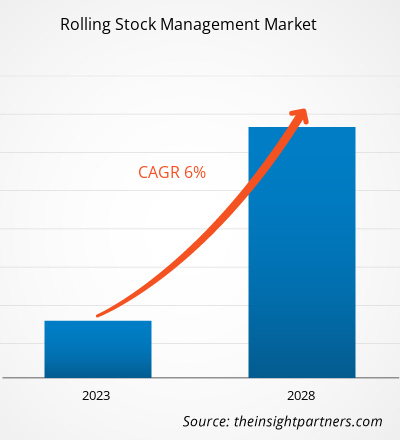[研究报告] 2022 年机车车辆管理市场价值为 485.7146 亿美元,预计到 2028 年将达到 687.6196 亿美元;预计 2022 年至 2028 年的复合年增长率为 6.0%。
分析师观点:
机车车辆是指包括动力和非动力车辆在内的铁路车辆。它是指能够在轨道上行驶的任何铁路车辆。机车车辆的维护、信息跟踪和管理是机车车辆管理系统的主要功能。它保存有关机车车辆运行以及故障和检查记录的信息。它还存储机车车辆从制造到主要配件的信息的记录。机车车辆历史记录的管理有助于工人在检查和故障期间有效地管理他们的工作。此外,该系统有助于将这些信息集中连接到交通管理系统、物料和会计系统、运输计划等。因此,机车车辆管理系统对于确定机车车辆和铁路行业的最佳性能是必不可少的。
市场概况:机车车辆管理市场
铁路行业的崛起是机车车辆管理市场的主要推动力之一。新火车站的不断增多和铁路网络的不断扩大催生了对高效机车车辆管理系统的需求,以管理机车车辆、其路线和维护。
下面列出了一些主要车站和铁路扩建项目:
- 2022 年 3 月,沙特阿拉伯铁路公司 (SAR) 根据该局开通北行客运列车的计划,启用了 Al-Qurayyat 客运火车站。
- 2023年3月,印度中央铁路局宣布计划新建6个郊区火车站,以满足孟买本地火车的需求。孟买铁路局共有80个车站,加上这6个车站,总车站数将达到86个。
定制此报告以满足您的需求
您可以免费定制任何报告,包括本报告的部分内容、国家级分析、Excel 数据包,以及为初创企业和大学提供优惠和折扣
- 获取此报告的关键市场趋势。这个免费样品将包括数据分析,从市场趋势到估计和预测。
市场驱动因素:机车车辆管理市场
铁路行业的扩张
全球对改善运输服务的需求正在迅速增长。根据国际能源署 (IEA) 的数据,与 2019 年相比,到 2050 年,客运和货运活动预计将翻一番。根据世界银行集团的数据,铁路被认为是运输客运和货运的最有效方式之一。由于运输活动不断增加,世界银行集团正在投资发展铁路行业,以提高其效率。许多组织正在向各个发展中国家的政府提供支持,以改革铁路基础设施并将铁路纳入国家交通网络。此外,发展中国家的政府也在投资以促进其铁路行业的发展。根据印度品牌资产基金会的数据,到 2030 年,该国将投资约 7154.1 亿美元用于铁路基础设施和发展。为了管理增加的客运和货运量,各国都在扩大其铁路基础设施。例如,2022 年 9 月,康涅狄格州交通部 (CTDOT) 在美国哈特福德县开设了一个新火车站。此外,2022年1月,沙特阿拉伯投资部长宣布该国将扩大铁路网8000公里的目标。机车车辆管理系统有助于提高机车车辆的最佳性能。铁路行业的扩张和发展正在创造对机车、货车和客运列车等机车车辆的需求,这进一步推动了对高效机车车辆管理系统的需求。
分部分析:机车车辆管理市场
根据管理类型,机车车辆管理市场分为铁路管理和基础设施。根据维护服务,机车车辆管理市场分为纠正性维护、预防性维护和预测性维护。从地理上讲,机车车辆管理市场分为北美、欧洲、亚太地区、中东和非洲以及南美。
区域分析:机车车辆管理市场
机车车辆管理市场分为五个主要区域——北美、欧洲、亚太地区 (APAC)、中东和非洲 (MEA) 和南美 (SAM)。全球航空机车车辆管理市场的增长归因于客流量的增加和火车站数量的增加。大多数传统铁路网络位于北美、欧洲和亚太地区。根据美国联邦运输管理局 2019 年的数据,这些地区占全球传统铁路客运量的约 90%,其中印度以 39% 领先,其次是中国 27%、日本 11% 和欧盟 9%。基础设施和乘客数量的不断增长推动了采购这些机车车辆的需求,以满足对增加的维护服务的需求。因此,火车站数量的增加推动了对铁路和车站之间效率、可靠性和安全性的机车车辆管理服务的需求,从而推动了机车车辆管理市场的发展。
关键参与者分析:机车车辆管理市场
机车车辆管理市场的主要参与者包括阿尔斯通公司、日立铁路有限公司、ABB 有限公司、三菱电机公司、西门子交通有限公司、Talgo SA、泰雷兹公司、东芝基础设施系统和解决方案公司、Trimble Inc 和 LocoTech LLC。许多公司都在投资机车车辆管理,因为这可能改善机车车辆的准确性、运营效率和及时履行订单。
机车车辆管理市场区域洞察
Insight Partners 的分析师已详尽解释了预测期内影响机车车辆管理市场的区域趋势和因素。本节还讨论了北美、欧洲、亚太地区、中东和非洲以及南美和中美洲的机车车辆管理市场细分和地理位置。

- 获取机车车辆管理市场的区域特定数据
机车车辆管理市场报告范围
| 报告属性 | 细节 |
|---|---|
| 2022 年市场规模 | 485.7亿美元 |
| 2028 年市场规模 | 687.6亿美元 |
| 全球复合年增长率(2022 - 2028) | 6.0% |
| 史料 | 2020-2021 |
| 预测期 | 2023-2028 |
| 涵盖的领域 | 按管理类型
|
| 覆盖地区和国家 | 北美
|
| 市场领导者和主要公司简介 |
|
市场参与者密度:了解其对商业动态的影响
机车车辆管理市场正在快速增长,这得益于终端用户需求的不断增长,这些需求源于消费者偏好的不断变化、技术进步以及对产品优势的认识不断提高等因素。随着需求的增加,企业正在扩大其产品范围,进行创新以满足消费者的需求,并利用新兴趋势,从而进一步推动市场增长。
市场参与者密度是指在特定市场或行业内运营的企业或公司的分布情况。它表明在给定市场空间中,相对于其规模或总市场价值,有多少竞争对手(市场参与者)存在。
在机车车辆管理市场运营的主要公司有:
- 阿尔斯通公司
- ABB有限公司
- 日立铁路有限公司
- 三菱电机公司
- 西门子交通有限公司
免责声明:上面列出的公司没有按照任何特定顺序排列。

- 获取机车车辆管理市场顶级关键参与者概述
最新发展:机车车辆管理市场
机车车辆管理市场中的公司大量采用并购等无机和有机战略。以下列出了机车车辆管理市场的一些近期关键发展:
- 2023年,阿尔斯通与纽约和新泽西港务局及纽瓦克自由国际机场签署合同,为其Innovia单轨系统——AirTrain Newark提供为期7年的运营和维护服务,直至2030年1月。合同价值超过2.6亿美元,并包含延长一年的选择权。
- 2023 年,ABB 获得了瑞士-瑞典跨国公司 Stadler 的 1.7 亿美元订单,为 300 多辆新列车和机车提供动力。这些列车用于欧洲各铁路网络,以现代化和加强英国、西班牙、葡萄牙、德国和奥地利等国家以及一些欧洲铁路走廊的列车运输。
- 2023 年,西门子交通交付了 1,200 台电力机车,并承诺提供 35 年的全方位维护服务。这被认为是西门子交通和西门子印度历史上最大的单笔机车订单。西门子交通借此巩固了其在市场上的地位。
- 2022 年,泰雷兹向利益相关者展示了新的列车技术,使英国铁路网络对轨道工人、列车乘务员和乘客来说更加安全。泰雷兹与 Network Rail 和西萨默塞特铁路公司 (WSR) 合作,现场演示了其列车保护和警告系统 - 持续监控 (TPWS-CS)。
- 历史分析(2 年)、基准年、预测(7 年)及复合年增长率
- PEST 和 SWOT 分析
- 市场规模价值/数量 - 全球、区域、国家
- 行业和竞争格局
- Excel 数据集



Report Coverage
Revenue forecast, Company Analysis, Industry landscape, Growth factors, and Trends

Segment Covered
This text is related
to segments covered.

Regional Scope
North America, Europe, Asia Pacific, Middle East & Africa, South & Central America

Country Scope
This text is related
to country scope.
常见问题
APAC is anticipated to grow with the highest CAGR over the forecast period.
The rolling stock management market was estimated to be US$ 48,571.46 million in 2022 and is expected to grow at a CAGR of 6.0 %, during the period 2022 - 2028.
The military drone market is expected to reach US$ 68,761.96 million by 2028
The key players, holding majority shares, in rolling stock management market includes Alstom SA, Siemens Mobility GmbH, Mitsubishi Electric Corp, Hitachi Rail Ltd, and Toshiba Infrastructure Systems and Solutions Corp.
The use of 5G in the rolling stock management provides higher bandwidth for the data transmission between the rolling stock and authorities engaged in its management. It also improves train-to-ground communications and helps the operators make better decisions regarding the action needed to maintain the reliable operation of the rolling stock.
1. Expansion of Rail Industry
2. Rising Safety and Security Concerns Regarding Rail Infrastructure
Trends and growth analysis reports related to Automotive and Transportation : READ MORE..
The List of Companies - Rolling Stock Management Market
- Alstom SA
- ABB Ltd
- Hitachi Rail Ltd
- Mitsubishi Electric Corp
- Siemens Mobility GmbH
- Talgo SA
- Thales SA
- Toshiba Infrastructure Systems and Solutions Corp
- Trimble Inc
- LocoTech LLC
The Insight Partners performs research in 4 major stages: Data Collection & Secondary Research, Primary Research, Data Analysis and Data Triangulation & Final Review.
- Data Collection and Secondary Research:
As a market research and consulting firm operating from a decade, we have published and advised several client across the globe. First step for any study will start with an assessment of currently available data and insights from existing reports. Further, historical and current market information is collected from Investor Presentations, Annual Reports, SEC Filings, etc., and other information related to company’s performance and market positioning are gathered from Paid Databases (Factiva, Hoovers, and Reuters) and various other publications available in public domain.
Several associations trade associates, technical forums, institutes, societies and organization are accessed to gain technical as well as market related insights through their publications such as research papers, blogs and press releases related to the studies are referred to get cues about the market. Further, white papers, journals, magazines, and other news articles published in last 3 years are scrutinized and analyzed to understand the current market trends.
- Primary Research:
The primarily interview analysis comprise of data obtained from industry participants interview and answers to survey questions gathered by in-house primary team.
For primary research, interviews are conducted with industry experts/CEOs/Marketing Managers/VPs/Subject Matter Experts from both demand and supply side to get a 360-degree view of the market. The primary team conducts several interviews based on the complexity of the markets to understand the various market trends and dynamics which makes research more credible and precise.
A typical research interview fulfils the following functions:
- Provides first-hand information on the market size, market trends, growth trends, competitive landscape, and outlook
- Validates and strengthens in-house secondary research findings
- Develops the analysis team’s expertise and market understanding
Primary research involves email interactions and telephone interviews for each market, category, segment, and sub-segment across geographies. The participants who typically take part in such a process include, but are not limited to:
- Industry participants: VPs, business development managers, market intelligence managers and national sales managers
- Outside experts: Valuation experts, research analysts and key opinion leaders specializing in the electronics and semiconductor industry.
Below is the breakup of our primary respondents by company, designation, and region:

Once we receive the confirmation from primary research sources or primary respondents, we finalize the base year market estimation and forecast the data as per the macroeconomic and microeconomic factors assessed during data collection.
- Data Analysis:
Once data is validated through both secondary as well as primary respondents, we finalize the market estimations by hypothesis formulation and factor analysis at regional and country level.
- Macro-Economic Factor Analysis:
We analyse macroeconomic indicators such the gross domestic product (GDP), increase in the demand for goods and services across industries, technological advancement, regional economic growth, governmental policies, the influence of COVID-19, PEST analysis, and other aspects. This analysis aids in setting benchmarks for various nations/regions and approximating market splits. Additionally, the general trend of the aforementioned components aid in determining the market's development possibilities.
- Country Level Data:
Various factors that are especially aligned to the country are taken into account to determine the market size for a certain area and country, including the presence of vendors, such as headquarters and offices, the country's GDP, demand patterns, and industry growth. To comprehend the market dynamics for the nation, a number of growth variables, inhibitors, application areas, and current market trends are researched. The aforementioned elements aid in determining the country's overall market's growth potential.
- Company Profile:
The “Table of Contents” is formulated by listing and analyzing more than 25 - 30 companies operating in the market ecosystem across geographies. However, we profile only 10 companies as a standard practice in our syndicate reports. These 10 companies comprise leading, emerging, and regional players. Nonetheless, our analysis is not restricted to the 10 listed companies, we also analyze other companies present in the market to develop a holistic view and understand the prevailing trends. The “Company Profiles” section in the report covers key facts, business description, products & services, financial information, SWOT analysis, and key developments. The financial information presented is extracted from the annual reports and official documents of the publicly listed companies. Upon collecting the information for the sections of respective companies, we verify them via various primary sources and then compile the data in respective company profiles. The company level information helps us in deriving the base number as well as in forecasting the market size.
- Developing Base Number:
Aggregation of sales statistics (2020-2022) and macro-economic factor, and other secondary and primary research insights are utilized to arrive at base number and related market shares for 2022. The data gaps are identified in this step and relevant market data is analyzed, collected from paid primary interviews or databases. On finalizing the base year market size, forecasts are developed on the basis of macro-economic, industry and market growth factors and company level analysis.
- Data Triangulation and Final Review:
The market findings and base year market size calculations are validated from supply as well as demand side. Demand side validations are based on macro-economic factor analysis and benchmarks for respective regions and countries. In case of supply side validations, revenues of major companies are estimated (in case not available) based on industry benchmark, approximate number of employees, product portfolio, and primary interviews revenues are gathered. Further revenue from target product/service segment is assessed to avoid overshooting of market statistics. In case of heavy deviations between supply and demand side values, all thes steps are repeated to achieve synchronization.
We follow an iterative model, wherein we share our research findings with Subject Matter Experts (SME’s) and Key Opinion Leaders (KOLs) until consensus view of the market is not formulated – this model negates any drastic deviation in the opinions of experts. Only validated and universally acceptable research findings are quoted in our reports.
We have important check points that we use to validate our research findings – which we call – data triangulation, where we validate the information, we generate from secondary sources with primary interviews and then we re-validate with our internal data bases and Subject matter experts. This comprehensive model enables us to deliver high quality, reliable data in shortest possible time.


 获取此报告的免费样本
获取此报告的免费样本